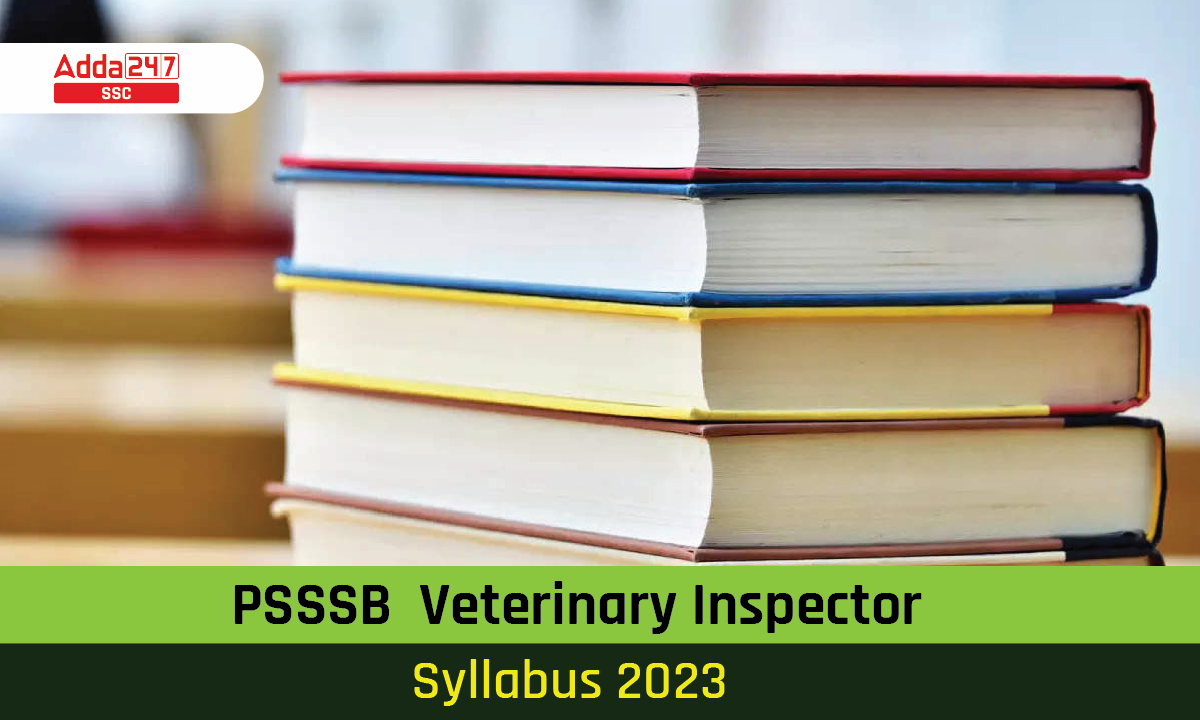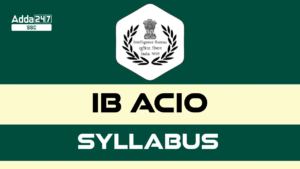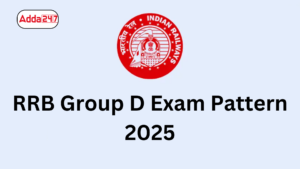PSSSB Veterinary Inspector Syllabus 2023
PSSB Veterinary Inspector Syllabus 2023: Are you looking for details for PSSSB veterinary inspector syllabus 2023? The article below mentions every detail about the PSSSB Veterinary Syllabus 2023 that you are looking for. Punjab Subordinate Service Selection Board has released a notification regarding the recruitment of candidates for the post of Veterinary Inspector. The examination for the post of veterinary Inspector was conducted on 07th May 2023.
PSSSB Veterinary Inspector Syllabus
The recruitment board has now concluded the application process for PSSSB Veterinary Inspector Recruitment 2023. To crack the exam candidates must check the PSSSB Veterinary Inspector syllabus 2023 beforehand. Below is the table that provides the overview of the PSSSB veterinary inspector syllabus 2023:
| PSSSB Veterinary Inspector Syllabus 2023: Overview | |
| Recruitment Board | Punjab Subordinate Service Selection Board(PSSSB) |
| Post | Veterinary Inspector |
| Total no. of vacancies | 644 |
| Advt. No. | 17/2022 |
| Category | Syllabus |
| Last date for online application | 27 March 2023 |
| PSSSB Veterinary Inspector Exam Date 2023 | 07th May 2023 |
| Job Location | Punjab |
| Official Website | http://sssb.punjab.gov.in/ |
PSSSB Veterinary Inspector Syllabus 2023
Knowing the PSSSB Veterinary Inspector Syllabus 2023 beforehand will help the candidates to drive their efforts in the very right direction. Below is the table that mentions the detailed subject-wise PSSSB veterinary inspector syllabus:
Part-A (Punjabi Qualifying Exam)
- Questions related to Biography and works of- Sri Guru Nanak Dev Ji, Sri Guru Angad Dev Ji, Sri Guru Ramdas Ji, Sri Guru Arjan Dev Ji, Sri Guru Teg Bahadur Ji
- Antonyms, Synonyms
- Idioms
- Prefix/Suffix
- Punctuation
- Write the words/ sentences correctly
- Questions related to the Punjabi Language
- Questions related to the History of Punjab
- Questions related to the culture of Punjab
Part-B (Subject Specific)
- Elementary Animal Husbandry: Common breeds of cattle, buffalo, sheep, goat, pig, horse, and poultry: Animal production systems: Principles of housing for farm animals: Routine management practices for various categories of livestock (calves, heifers, pregnant and lactating animals, etc.) and sick animals: Introduction to methods of castration: Milking techniques: Clean milk production concept, significance, and factors affecting clean milk production; Sanitation and hygiene practices: Routine farm practices including wallowing, watering, and bathing; Recordkeeping and responsibilities of veterinary inspector/ para- veterinarian: waste management, Identification techniques in animals, Biosecurity methods at livestock farm.
- Elementary Livestock Handling: An overview of animal behavior, Common tools used for animal control: Methods of restraint and handling of animals: Dentition, Farrier practices and shoeing, Hoof trimming in bovine: Prevention of cruelty to animals, Preparing animals for show/ animal fair.
- Elementary Animal Nutrition: Principles of animal nutrition; Digestive systems including rumination: Nutritional importance of carbohydrates, lipids, proteins, vitamins, minerals, and water. Common feeds and fodders: Scientific feeding and feeding schedule for different categories of livestock: Colostrums feeding. How, when, and why to feed colostrum to calves Feeding practice of cow & buffalo-Ration balancing: Anti-nutritional factors: Feed additives: Hay and Silage making. Precautions in the storage of feed and fodder.
- Basic Computer Applications: Knowledge about computer accessories. Use of computers in handling and presenting veterinary and livestock data. Working in Windows operating system. Working with MS Word, Spreadsheets using MS Excel, Graphics and MS PowerPoint, internet, and World Wide Web. E-mail and internet services: Computer viruses, antivirus. Practice in Form data recording.
- Elementary Anatomy and Physiology of Animals: Introduction to anatomy and physiology of musculoskeletal, digestive, cardiovascular, respiratory, nervous, and excretory. Male and female reproductive and endocrine system: Mammary glands of domestic animals: Body cavities (Thoracic, abdominal, and Pelvic) and their related organs. Basic physiological parameters of domestic animals.
- Elementary Pharmacology: Introduction to Pharmacology, Nature, and sources of drugs: Routes of drug administration: Dosage forms: Pharmaceutical processes: Handling of hazardous substances: Common antiseptics and disinfectants: Weights and measures: Pharmacy calculations Classification of important drugs: Important Indigenous and allopathic drugs.
- Elementary Veterinary Epidemiology and Public Health: Introduction to epidemiology, surveillance, and monitoring of common seasonal infectious diseases like Brucellosis, Rabies, Cysticercosis, TB, JD, Anthrax, FMD, and Foodborne pathogens. Public health considerations: Common zoonoses and their management: Disposal of cadavers: Concept of contagious, notifiable diseases and outbreaks.
- Elementary Poultry Science: Poultry types-Layer Broiler: Common breeds/strains of poultry: Meat and egg productivity, and production, Different housing/rearing systems: Management of layer and broiler farm: Brooding: Hatchery routines: Cleaning of poultry sheds and litter management: Biosecurity: Feeding and poultry ration: Introduction to common poultry diseases: Vaccination.
- Elementary Animal Husbandry Extension: Extension in rural welfare: Community development and rural sociology: Principles and objectives of veterinary and animal husbandry extension Qualities of extension worker: Extension teaching methods Extension and training programmers. Duties of veterinary inspector/ para veterinarian: Communication tools and Role of media, Set-up of Animal Husbandry Department, Record maintenance at Veterinary Hospital, Government schemes for farmers’ benefits.
- Elementary Animal Reproduction: Female genitalia of cattle, buffalo, and goats, Reproductive cycle, Puberty, Oestrous cycle: Methods of heat detection including fern pattern: Gestation in domestic animals: Methods of pregnancy diagnosis: Abortion in domestic animals: Parturition and impending signs. Types of infertility in farm animals-causes and remedies: Sexual health and herd health program: Care and management of dom and newborn calf. Introduction to parturient problems in dairy animals.
- Elementary Andrology and Artificial Insemination: Study of male genitalia and gonads: Puberty, Methods of semen collection and storage: Handling of fresh/frozen semen: Artificial insemination including optimum time of AI: Diseases transmitted through semen.
- Elementary Parasitology: Introduction to common parasites I.e., protozoa (Theileria. Babesia. Anaplasma, and Trypanosomes). Trematodes (Liver flukes. amphistomes and lung flukes). cestodes (Moneizio, Dipylidium caninum, Toeniosis. Hydatid cyst). nematodes (Toxocara. Haemonchus. Lungworm, filarial nematodes, etc) and arthropods ficks, and Mites. Fleas and myiasis) in livestock: Economic importance of parasitic diseases of livestock.
- Procurement, Handling, and Testing of Milk: History of dairy development in India. Three-tier structure of dairy cooperative. An introduction to the Indian dairy industry with special reference to the dairy sector in Punjab. Milk- definition, its composition. factors affecting the quality of milk and standards. Milk collection systems and their handling (transportation. reception and storage). Platform tests for quality analysis of milk. Important sanitary and hygienic practices for milk handling. Cleaning and its importance. Introduction to common detergents & sanitary agents. Milk pricing system and its concept.
- Basic Livestock Health Management: Introduction to common diseases of livestock: Hemorrhagic Septicaemia. Brucellosis. Tuberculosis. Foot and Mouth disease. Rabies. John’s disease. Glanders. Theileriosis. Classical swine fever. etc. insecticide toxicities. Preventive health measures for bacteria, viral and parasitic diseases in various species.
- Veterinary Hospital Maintenance: Maintenance of case records and fig books of scheduled drugs Basic accounting: Preparation of bills and maintenance of a consumable and non-consumable stock of hospital: History taking, Prescription reading, and dispensing of drugs. Preparation of animals for surgical operation: Core and maintenance of surgical. anesthetic and other common equipment: Assisting veterinary surgeons in post-operative core: Hospital hygiene. Sterilization of operation theatre: Surgical pack and surgical instruments: Types of suture material. Categorization of biomedical waste, and its disposal as per pollution control board regulations.
- Elementary Veterinary Medicine: Introduction to digestive, respiratory. urinary and production systems and their diseases (Milk fever. Ketosis: Haemoglobinuria): Preliminary knowledge about indigestion. blood, constipation, diarrhea, aspiration pneumonia, and urinary incontinence. Mastitis: Common mineral and vitamin deficiencies. Hoof care.
- Elements of Wound Care and Management: Wound causes, classification: Types of wound dressings: Basic concepts of the abscess. ulcers. hematoma, cyst, tumor, and hernia: Clinical use of antiseptics, fly repellents. anti-maggot, etc.: First aid in sick animals including fracture cases. Management of bloat: Hoof care.
- Basic Clinical Pathology and Laboratory Techniques: Handling of laboratory equipment. glassware and chemicals: Cleaning and sterilizing of laboratory wares: Basic microscopy principles: Blood collection techniques: Use of anticoagulants: Serum and plasma separation: Urine collection, preservation, and common physical end chemical tests: Collection, preservation, and dispatch of tissues for histopathology. Protocols for a necropsy of mammals and poultry birds.
- Practical On-Farm/Farmer’s Door Training: Handling, and management practices of Dairy farms. Stud Form, Poultry Farm. Piggery Farm. Sheep and Goat farm, Routine form operations including vaccination, etc. Communication with farmers; Use of audio and visual aids for training 1 of farmers: Organizing farmer interactions. Extension programs viz. Kison Melo, Livestock shows, Animal markets, and Animal welfare comps.
- Practical In-Clinics Training: Handling and dealing with sick animals. Record keeping: History taking: Sampling of body fluid/tissues: Medication: Post-operative management of surgical patients: Core of pregnant animals: Vaccination: Preparation of solutions, lotions, tinctures, ointments, mixtures (carminatives. laxatives. purgatives, febrifuge, etc.) Electuaries, etc.
- Practical Lab/Hospital Training: Handling of laboratory equipment; Methodology for transporting various samples to the laboratory for examination; Blood smear preparation; Staining; Complete blood count; Serum and plasma separation; Preservations of serum, plasma, and tissues; Urine examination; Preparation of smears for fecal examination.
- Practical Bull Centre Training: Management of breeding bull; preparation of dummy; Artificial vagina preparation; preparation of extenders; Handling of chilled and frozen semen, storage of semen; handling of liquid nitrogen including its containers; record keeping.
Part-B (General knowledge, Logical Reasoning, English and Punjabi)
1. General Knowledge :
(i) Political issues
(ii) Environment issues
(iii) Current Affairs
(iv) Science and Technology
(v) Economic issues
(vi) History of Punjab-14th century onwards
(vii) History of India with special reference to Indian freedom
struggle movement.
(viii) Sports,
(ix) Cinema and Literature
2. Logical Reasoning
- Verbal reasoning: Coding, Decoding, Analogy, Classification, Series, Direction sense test, relations, mathematical operations, time test, the odd man out problems.
Non-Verbal Reasoning: Series, Analogy, and Classification. Basic numerical skills, Percentage, Number system, LCM, and HCF, Ratio and Proportion, Number series, Average, Problems based on Ages, Profit & Loss, Partnership and Mixture, Simple and Compound Interest, Work and Time, Time and Distance. Mensuration and Data Interpretation.
3. English
Basic Grammar, Subject and Verb, Adjectives and Adverbs, Synonyms, Antonyms, One Word Substitution, Fill in the Blanks, Correction in Sentences, Idioms and their meanings, Spell Checks, Adjectives, Articles, Prepositions, Direct and Indirect Speech, Active and Passive Voice, Correction in Sentences, etc.
4. Punjabi
Synonyms/optimal words, nouns, pronouns and types of verbs and their correct usage, gender and speech, Punjabi proverbs and idioms, English to Punjabi translation and multiple word substitution, etc.
PSSSB Veterinary Inspector Exam Pattern 2023
| PSSSB Veterinary Inspector Syllabus 2023: Exam Pattern | |||
| Particular | Topic | No. of questions | Maximum Marks |
| Part-A | Punjabi (Qualifying Nature) | 50 | 50 |
| Part-B | Questions from the Specific Subjects | 70 | 70 |
| Questions from Questions) General Knowledge, English, Logical Reasoning and Mental ability, Punjabi | 30 | 30 | |
PSSSB Veterinary Inspector Syllabus 2023: Highlights
- Objective Type Questions
- No negative marking for part A
- There will be a negative marking for part B. For every wrong answer. 1/4 mark would be deducted.
- Total time duration: 2 hours 30 minutes.
| Related PSSSB Veterinary Inspector Posts | |
| PSSSB Veterinary Inspector Recruitment 2023 | PSSSB Veterinary Inspector Salary |
| PSSSB Veterinary Inspector Qualification | PSSSB Veterinary Inspector Exam Date 2023 |



 IB ACIO Syllabus 2025 and Exam Pattern f...
IB ACIO Syllabus 2025 and Exam Pattern f...
 RRB Group D Exam Pattern 2025 for CBT 1 ...
RRB Group D Exam Pattern 2025 for CBT 1 ...
 SSC CHSL Syllabus 2025 and Exam Pattern ...
SSC CHSL Syllabus 2025 and Exam Pattern ...


